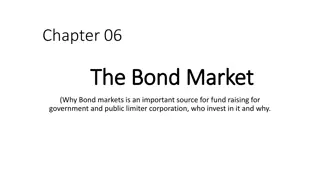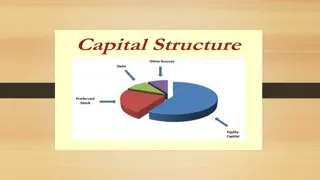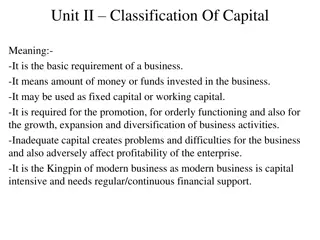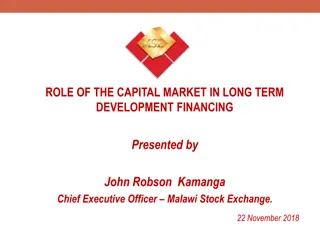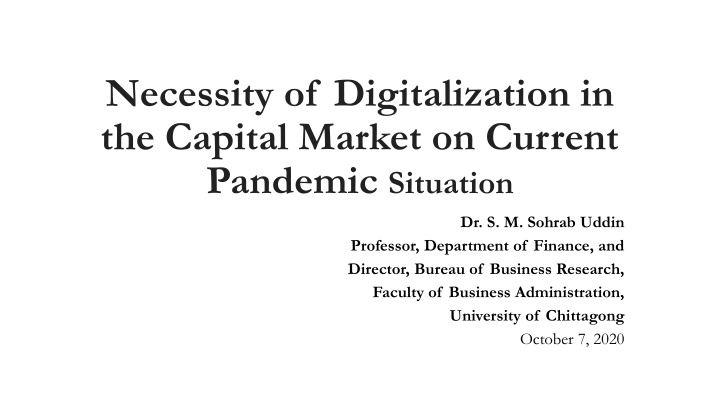
Digitalization in Capital Markets During Pandemic Era
"Explore the necessity of digitalization in capital markets amidst the current pandemic situation, as discussed by Dr. S. M. Sohrab Uddin. Learn about digital transformation, types of digital technology, and the evolution of digitalization in capital markets. Discover how electronic trading enhances liquidity and reduces capital costs."
Download Presentation

Please find below an Image/Link to download the presentation.
The content on the website is provided AS IS for your information and personal use only. It may not be sold, licensed, or shared on other websites without obtaining consent from the author. If you encounter any issues during the download, it is possible that the publisher has removed the file from their server.
You are allowed to download the files provided on this website for personal or commercial use, subject to the condition that they are used lawfully. All files are the property of their respective owners.
The content on the website is provided AS IS for your information and personal use only. It may not be sold, licensed, or shared on other websites without obtaining consent from the author.
E N D
Presentation Transcript
Necessity of Digitalization in the Capital Market on Current Pandemic Situation Dr. S. M. Sohrab Uddin Professor, Department of Finance, and Director, Bureau of Business Research, Faculty of Business Administration, University of Chittagong October 7, 2020
Industrial Revolution Dr. S. M. Sohrab Uddin, Professor, Department of Finance, CU 2
What is Digitalization? Digital transformation, also known as digitalization, is defined as the changes a firm goes through as it starts to use digital technologies to develop a new digitally-enabled business model to create and appropriate more value for the firm (Kane et al. 2019; Liu et al. 2011; Schallmo et al. 2017). Digitalization refers to turning interactions, communications, business activities, and business models into (more) digital ones. Thus, a digital firm is an organization that partially or fully manages significant business processes and relationships with its stakeholders (suppliers, customers, employees, business partners . . .) by digital means (Laudon & Laudon, 2019; Soto-Acosta et al., 2016). Dr. S. M. Sohrab Uddin, Professor, Department of Finance, CU 3
Types of Digital Technology Digital technology is the building block of digital transformation (Chan et al. 2019), and nine types of such technology have been identified, which include big data and analytics, simulation, horizontal and vertical system integration, Internet of things (IoT), cybersecurity, cloud computing, additive manufacturing, and augmented reality (R mann et al. 2015). autonomous robots, Dr. S. M. Sohrab Uddin, Professor, Department of Finance, CU 4
Digitalization in the Capital Market The Start of Digitization 1987: The 1987 stock market crash set into motion a process weak at first, stronger over the years that has ended with computers entirely replacing the people . The Privatization of Stock Exchanges 2005-2007: In 2005, the US government passed regulation that forced stock exchanges like NASDAQ and the New York Stock Exchange to become publicly traded companies. The Opening of Custodial Services 2012: The broker started to provide full- stack of brokerage services, which included custody and clearing of securities. The Pursuit of Artificial Intelligence (AI) and Financial Intelligence 2015: Use of AI and machine learning for a competitive edge. Dr. S. M. Sohrab Uddin, Professor, Department of Finance, CU 5
Digitalization in the Capital Market Electronic trading enhances the liquidity and informativeness of stock markets leading to a reduction in cost of capital. In addition, electronic systems are capable of attracting new pools of liquidity by providing affordable remote access to investors and by retaining unexecuted orders in a consolidated order book for possible matching with future orders. This phenomenon is further facilitated by the manifestly higher speed of execution and settlement of trades on electronic systems. Electronic systems are also more transparent than trading floors in displaying detailed order-flow information such as quotes, depths, and recent transactions from the limit order book to the market participants in real time. Higher ex-ante transparency reduces the adverse selection problem (Pagano and Roell, 1996). Dr. S. M. Sohrab Uddin, Professor, Department of Finance, CU 6
Digitalization in the Capital Market of Bangladesh CSE DSE CDBL Automated trading system in the name of CHITTRA was introduced on June 1998; Much awaited Next Generation Trading system (NGTS) was launched on October 20, 2011; CSE Internet Trading System for the investors is available; CSE Mobile Application CHITRA and CSE Mobile Application CSE Cloud are now available. DSE launched its next generation trading platform on December 11, 2014; DSE-Mobile, an application developed by FlexTrade systems, is available. Central Depository Bangladesh Limited incorporated in 2000 and came into operation in 2003. Source: BSEC (2017) Dr. S. M. Sohrab Uddin, Professor, Department of Finance, CU 7
How Digitalization Helps to Stay Competitive? Digital transformation does not necessarily mean that companies have to abandon their existing business models, rather it consists of new digital or digitally improved business models usually complement existing traditional ones. The most highly digitally transformed sectors have posted two to three times higher rates of growth in profit margin, than others, and wages, than the national average. Firms with advanced digital assets and capabilities have generated higher rates of revenue growth and higher return to shareholders. The have-mores are not just large firms that dominate one sector. They can also be small, innovative firms or firms whose digital assets enable them to play in multiple sectors. Dr. S. M. Sohrab Uddin, Professor, Department of Finance, CU 8
How Digitalization Helps to Stay Competitive? Automation will not replace jobs (or not many), but routine tasks, which do not require interpersonal human skills such as empathy or qualified knowledge. Over the last fifty years, unemployment has been more influenced by the business economic cycle than technology, with the economic crises not being caused by technology (Reese, 2018). In fact, there is room for improvement, since it is estimated that we as employees spend 80% of our working time doing trivial tasks, which represent 20% of results, while the remaining 80% of results come from the few vital tasks to which we dedicate only 20% of our time. Digital technologies are responsible for the creation of totally new jobs, for instance, Youtubers and Tiktokers. Markets may have given eminence and greater confidence to firms and sectors with a higher level of digital transformation as they are positioned better to sustain operations not only amid the pandemic, but also to recover faster in the post-COVID-19 period. Many are also predicting the emergence of a post-COVID-19 period, where digital transformation will be prominent. Dr. S. M. Sohrab Uddin, Professor, Department of Finance, CU 9
Digital Transformation Across Sectors McKinsey Global Institute s (MGI) examines the state of digital transformation across various sectors and finds that there is a large and growing gap across the sectors. i. Knowledge-intensive sectors that are highly transformed digitally across most dimensions; ii. Capital-intensive sectors with the potential to further transform their physical assets digitally; iii. Service sectors with a long tail of small firms having room to transform their customer transactions digitally; iv. B2B sectors with the potential to digitally engage and interact with their customers; v. Labor-intensive sectors with the potential to provide digital tools to their workforce; vi. Quasi-public and/or highly localized sectors lagging across most dimensions. Dr. S. M. Sohrab Uddin, Professor, Department of Finance, CU 10
Influences of Epidemics The Severe Acute Respiratory Syndrome (SARS) Influenza COVID-19 Ebola 1% drop in China s GDP Economic damage of USD54 billion worldwide The global cost can be USD4.1 trillion US encountered a deficit of USD53 billion 5% gross domestic product (GDP) of the US was reduced Dr. S. M. Sohrab Uddin, Professor, Department of Finance, CU 11
COVID-19 and the Stock Market The onslaught of the 2019 novel coronavirus disease (COVID-19) pandemic has impacted stock markets worldwide, with the stock prices of many firms seeing unprecedented fall. The market value of the world s major stock index, such as the Standard & Poor (S&P)500, National Association of Securities Dealers Automated Quotations System (NASDAQ)100, and Nikkei225 dropped nearly 30% since the outbreak of COVID-19. Studies in behavioral finance have shown that investors may over-react in the short term when they become extremely pessimistic during downturns or place too much importance on recent events while ignoring historical data. By observing top 25 most affected countries stock market, Pan and Narayan (2020) mention that during the early stages stock prices in the vast majority of the countries reacted negatively. However, with time, as countries reached 100,000 infections and 100 deaths, for example, the reaction in 50% of the markets was positive, suggesting a possible market correction. Dr. S. M. Sohrab Uddin, Professor, Department of Finance, CU 12
Immediate COVID-19 Impacts on Bangladesh Stock Market The first COVID-19 case in Bangladesh was announced on March 8. The announcement caused a huge drop in investors confidence. Bangladesh remained the country where the stock markets were closed for two months due to the coronavirus pandemic. Bangladesh Securities and Exchange Commission (BSEC) issued a circular that the opening price of the listed security will be set on the average closing price of preceding five trading days and the average price will be considered as the floor price and lower limit of the circuit breaker. The BSEC has lifted the floor price on June 15. Finally, the stock markets opened on May 31 after a 66-day. Dr. S. M. Sohrab Uddin, Professor, Department of Finance, CU 13
Indicators of DSE DSE Broad Index 5138.79 5095.78 4947.64 4682.90 4731.44 4452.93 4469.66 4480.23 4008.29 4060.45 3989.09 4214.43 4879.15 End of Period Jul-19 Aug-19 Sep-19 Oct-19 Nov-19 Dec-19 Jan-20 Feb-20 Mar-20 Apr-20 May-20 Jun-20 Jul-20 Aug-20 Turnover (BDT Billion) 89.47 73.98 84.95 70.20 74.10 67.02 80.72 124.28 66.46 1.43 47.8 60.01 186.18 Enlisted Issues 356 357 357 357 357 358 360 360 360 360 360 362 361 362 Source: Bangladesh Bank (2020) Dr. S. M. Sohrab Uddin, Professor, Department of Finance, CU 14
Indicators of CSE End of Period Jul-19 Aug-19 Sep-19 Oct-19 Nov-19 Dec-19 Jan-20 Feb-20 Mar-20 Apr-20 May-20 Jun-20 Jul-20 Aug-20 CSE All Share Price Index 15725.46 15580.60 15046.73 14221.78 14392.43 13505.70 13586.40 13742.96 11328.00 11332.59 11957.06 13908.14 Turnover (BDT Billion) 4.79 4.80 5.47 4.19 5.17 3.96 4.10 6.20 4.84 9.53 3.50 5.94 Enlisted Issues 327 328 328 328 328 329 331 331 331 331 331 331 332 333 Source: Bangladesh Bank (2020) Dr. S. M. Sohrab Uddin, Professor, Department of Finance, CU 15
COVID-19 and the Stock Market: The Role of Digitalization Reports have indicated that even as most corporeal economic activities halted, trade and consumption continued to take place online as consumers were spending more time and money online as the virus peaked (Huang et al. 2020). It is observed that digital technology and connectivity have emerged as essential tools and an alternative to their physical equivalents in combating the adverse effects of the pandemic and enhancing societal and economic resilience (Atsuko and Karazhantva 2020). Particularly, Ding et al. (2020) argue that sectors with higher levels of digital transformation remain resilient to the impact of the market sentiment from the COVID-19 pandemic, while sectors that lag across most digital transformation dimensions are among the most negatively affected. In the current pandemic-led stock market crash, interestingly, certain industries and firms are able to withstand the adverse effect and turn the crisis into opportunities by providing/using digital solutions to expand their business. Thus, their stock prices are not negatively affected by the market s downturn. For example, the stock price of Zoom Video Communications, Inc. (the major provider of online conference platforms) has increased from USD70 in early January 2020 to USD150 by the end of March 2020 amidst the market crash. Dr. S. M. Sohrab Uddin, Professor, Department of Finance, CU 16
COVID-19 and the Stock Market: The Role of Digitalization Firms that have undergone digital transformation are likely to have a better chance of performing better amidst the pandemic as they are more capable of maintaining some degree of operation and revenue stream for their businesses. Market sentiment toward such firms may thus be stronger and, consequently, translate into more resilient stock prices. Dr. S. M. Sohrab Uddin, Professor, Department of Finance, CU 17
Digitalization in the SMEs SMEs have adopted various digital technologies to cope with this crisis. A study on 518 Chinese SMEs with an objective of examining the relationship between SMEs digitalization and their public crisis responses reveals that digitalization has enabled SMEs to respond effectively to the public crisis by making use of their dynamic capabilities (Guo et al. 2020). In addition, digitalization can help improve SMEs performance. Dr. S. M. Sohrab Uddin, Professor, Department of Finance, CU 18
Mobile or Web Based Trading Spending less time and an easier access to information; Because of online trading efficiency, it is estimated that around 40 million people in the US utilize computers in trading stocks; Notifications and alarms for news, stock reports, etc. Advantages Investors may need some additional help; Many investors may not have strong financial background; Challenges Suitable website quality; Easy to operate; Trust and image are of significant importance; Service quality; Cost Points to be noted Dr. S. M. Sohrab Uddin, Professor, Department of Finance, CU 19
Opportunities for the Future New ways of working will foster the demand for new talent regardless of people's geographical location. Moreover, cybersecurity and privacy will become two key elements that will support the integrated development of the Internet of Things technology solutions, artificial intelligence, big data, and robotics. Official response time and the size of stimulus package provided by the governments matter in offsetting the effects of the pandemic in the 26 emerging stock markets (Topcu and Gulal, 2020). Dr. S. M. Sohrab Uddin, Professor, Department of Finance, CU 20
2018 and 2019: Negative Growth in the Bangladesh Stock Market The liquidity crisis in the banking sector; Aggressive bank borrowing by the government; Depreciation of the Bangladesh Taka against the US Dollar; Besides, issues such as the clash of Grameenphone with BTRC over default payments, liquidation of People s Leasing and Financial Service Limited, poor payout ratio of listed companies, and reduction in price of large-cap companies like BATBC, Square Pharma, and United Power have also worsened the situation. Dr. S. M. Sohrab Uddin, Professor, Department of Finance, CU 21
Market Capitalization to GDP Ratio (in percentage) Source: IDLC Monthly Review Dr. S. M. Sohrab Uddin, Professor, Department of Finance, CU 22
How to Retrieve Investors Confidence? Electronic trading for continuous transactions; Dhaka Stock Exchange collaborated in a strategic partnership with the Shenzhen Stock Exchange to launch the CNI-DSE Select Index (CDSET) comprising 40 companies. There are also plans to launch Size-Based Indices like CNI-DSE Large- Cap Index, CNI-DSE Mid-Cap Index, and CNI-DSE Small-Cap in the coming days, which will attract foreign investment; Development of a vibrant bond market; Introduction of derivative instruments. Dr. S. M. Sohrab Uddin, Professor, Department of Finance, CU 23
Thank You Dr. S. M. Sohrab Uddin, Professor, Department of Finance, CU 24










